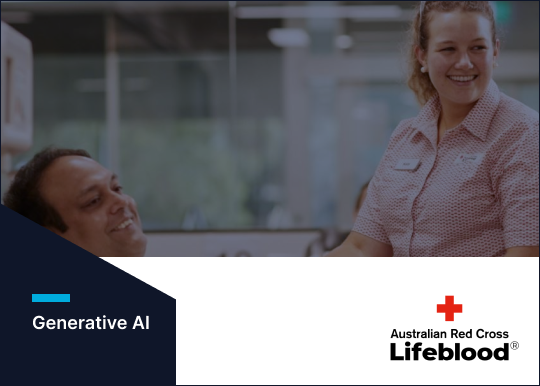CASE STUDY
Australian Red Cross Lifeblood: Boosting productivity with generative AI

At a glance
DiUS advanced Australian Red Cross Lifeblood’s generative AI journey by creating pilots that demonstrated tangible time savings for its workforce. By pairing Lifeblood’s domain experts with generative AI, engineering, and design expertise, DiUS took a cross-functional approach to ensure the pilots delivered real business value. Instead of rushing to a large language model-based solution, the team focused on understanding Lifeblood’s specific data environment. They prioritised using non-health related corporate data to minimise risk and adhered to strict data privacy and security standards. This careful approach involved unpacking problems, designing user experiences, leveraging state-of-the-art generative AI models, and conducting user tests to drive improvements. Success was measured not only by productivity improvements but also by the valuable insights gained to guide future generative AI implementations.
Our services
Meet Lifeblood
Lifeblood has been one of the most trusted not-for-profit health service providers in Australia for over 90 years. Lifeblood’s life-giving work supports patients and recipients across the nation through blood, plasma, transportation, specialised testing services, educational resources, and other biological products. This is made possible by over half a million donors, around 3,500 employees, more than 1,000 non-donor volunteers, 102 blood collection facilities, and four major processing centres around Australia.
The challenge
Leverage generative AI to enhance productivity and align with Lifeblood’s long-term goals
Lifeblood’s exploration of generative AI was driven by various internal and external influences. Staff across the organisation were independently using tools like ChatGPT, while vendors were incorporating generative AI into their products, potentially introducing it to Lifeblood’s systems. Against this backdrop, the innovation team proactively sought to understand how generative AI would fit into the organisation’s future.
Cross-business ideation workshops identified over 200 potential business problems, which were further refined using value mapping. One of the main themes from these sessions was productivity, a focus that aligned with Lifeblood’s strategic theme of the “Workplace of Champions,” centred on making its people feel empowered to do meaningful work.
Lifeblood operates in a highly sensitive data environment, handling private health data. To manage these sensitivities, initial experiments focused on non-health-related corporate data and secure instances for AI experimentation. Four key projects were selected, aligning with strategic goals and focusing on productivity of employees as well as translating data into human readable insights:
- Navigating complex donor eligibility documentation: Nurses were spending excessive time searching, understanding, and communicating complex eligibility criteria to donors, resulting in an inefficient and prolonged donor interview process.
- Searching standard operating procedures: Staff faced challenges in quickly finding and understanding the right information. For example, searching a PDF or printed document that contains the appropriate temperatures and conditions for storing blood products.
- Manual summarisation of complex scientific research documents: Producing insights from the latest research and publications tailored for different audiences and stakeholders was time consuming for researchers.
- Generating financial commentaries: Producing regular financial updates and commentary for senior leadership was a labour-intensive process for the finance team.
Given the heavily regulated nature of the industry and the sensitivity of the data handled, Lifeblood needed to approach the adoption of generative AI with caution. To navigate this new technology safely, Lifeblood enlisted DiUS, a long-term technology partner and leading AI consultancy to rigorously develop, test and develop pilots.
What we did
Build generative AI pilots to inform business adoption
The brief was to support sensible, safe and tangible useful experimentation of generative AI. DiUS knew the key was to deliver working generative AI pilots that could be placed into the hands of Lifeblood staff. This would deliver an understanding of where the new technology is adding value and how.
DiUS employed a collaborative and iterative approach to assist Lifeblood in planning and executing, with the aim of minimising risks and maximising impact. Educating Lifeblood’s team about generative AI and its applications was an important first step. Then helping Lifeblood unpack and understand their business problems, validating that these problems were suitable for generative AI.
Emphasising cross-functional collaboration, DiUS involved its engineering, design, product, and generative AI experts along with Lifeblood’s domain experts. This ensured that solutions were well integrated into Lifeblood’s business context. DiUS applied the Desirability, Viability, and Feasibility (DVF) framework to assess solutions, ensuring they were user-friendly, commercially viable, and technically feasible.
A significant focus was placed on design and user experience, integrating experience design principles throughout the process to ensure solutions effectively addressed the needs of Lifeblood’s staff and stakeholders. An enhanced user experience was essential, as many previous internal tools had failed due to poor usability, despite being functionally sound. User feedback was also integral to getting feedback for the iterative development process. It helped understand edge cases, gaps in functionality, and inform future improvements.
Conducting technical experiments to test the feasibility and effectiveness of generative AI solutions was a key part of DiUS’s approach. Experimenting with different generative AI technologies and configurations, such as indexing and chunking, enhanced the performance of language models. DiUS also sequenced the pilots to validate foundational learnings and basic assumptions before moving on to more complex ones.
Given Lifeblood’s handling of private health data, DiUS set up secure Microsoft Azure cloud instances for generative AI experimentation to address data privacy and security concerns. Ensuring adherence to strict data handling requirements was paramount, and DiUS took necessary steps to maintain data integrity and confidentiality.
Through in-depth experiments, continuously iterating based on user feedback, and testing for accuracy and speed, DiUS developed pilots that addressed the first three of Lifeblood’s problem statements.
Navigating complex donor eligibility documentation
A generative-AI powered search tool, a donor guidelines copilot, was developed to help staff in donor centres reduce time searching the 450-page “Guidelines for the Selection of Blood Donors” document during donor interviews. The pilots involved substantial data preparation, including OCR (Optical Character Recognition) to convert PDF documents into searchable text and careful chunking to preserve the document’s structure and context. The implementation of the Retrieval Augmented Generation (RAG) solution utilised the latest OpenAI GPT foundational model, query rewriting, and vector search, it handles complex text and tables effectively even handling spelling errors as part of the search. Also, the solution’s user-friendly design features a conversational interface paired with a document viewer so that staff can interact with the tool while viewing the document. Staff can quickly find relevant guidelines with citations that reference the original document for accuracy and regulatory compliance.
Searching standard operating procedures
A generative AI-powered tool was designed to simplify the search and retrieval of standard operating procedures and work instructions. Combining semantic search with traditional text-based methods, users can find relevant documents based on meaning rather than exact matches to titles or document numbers. Vector search, query rewriting, and metadata filtering was used to enhance search results, handling complex document structures like tables and cross-references. The user-friendly interface integrates a document viewer with a conversational AI, allowing users to interact with the tool while viewing documents. With pre-generated summaries, users can rapidly determine the relevance of procedures, and the accompanying citations and links facilitate quick checks against original documents, preserving accuracy and regulatory compliance.
Manual summarisation of complex scientific research documents
A generative AI-powered tool to streamline the summarisation of complex research papers and lengthy documents. Utilising tree summarisation techniques, it breaks down large documents into smaller parts, generates summaries for each part, and synthesises an overall summary. The user-friendly interface allows users to select specific sections for summarisation, ensuring tailored summaries for different stakeholders. By applying vector search and query rewriting, the tool accurately handles complex text, including tables and figures. Pre-generated summaries enable quick assessment of information relevance, and citations with links ensure verification against original documents for accuracy and compliance.
The solution for the financial report commentary generator encountered technical hurdles, such as slow response times and the complexity of the financial data. The solution allowed generative AI to directly query structured financial data in SQL databases. Further, agents were used to manage data queries and calculations as LLMs don’t perform arithmetic well. The use of a conversational interface also allowed for more interactive and user-friendly engagement with the system. Ultimately, while the solution was not fully realised, the resultant pilot demonstrated the ability to connect to multiple financial data sources, query deeper insights, and produce coherent financial commentaries.
Results for Lifeblood
Ready for what’s next with generative AI
By combining Lifeblood’s deep knowledge of its workflows with DiUS’ expertise in experience design and AI/ML, innovative problem-solving was achieved in a compressed timeline. This collaborative approach allowed Lifeblood to explore the potential impact of generative AI on its business without incurring significant upfront costs.
Lifeblood measured the success of the pilots through its “Workplace of Champions” strategic theme, focusing on productivity benefits for internal staff. The primary metric was how much time the generative AI solutions saved in various tasks, such as comparing the time taken to search for information using the new AI tool versus traditional methods in the donor guidelines pilot. The outcomes were assessed using the Desirability, Viability, and Feasibility (DVF) framework to determine which ones would be prioritised for investment to go into production.
Assessing the ease and intuitiveness of the AI tools was equally important. Continuous user feedback gathered through the development process provided real-world assessments of the practicality and benefits of the solutions. Ensuring that the generative AI solutions adhered to regulatory requirements was also a key success metric, particularly for tools handling health data, which is critical in Lifeblood’s regulated environment.
Overall, the success of the initiative was not just about demonstrating that the technology worked but also about informing future decisions around generative AI. This iterative testing and learning process provided valuable insights, helping Lifeblood understand necessary production requirements and optimise future generative AI implementations. As Lifeblood considers whether to sustain and expand these initiatives, it is also evaluating the capability and skill sets needed to support ongoing generative AI efforts.



